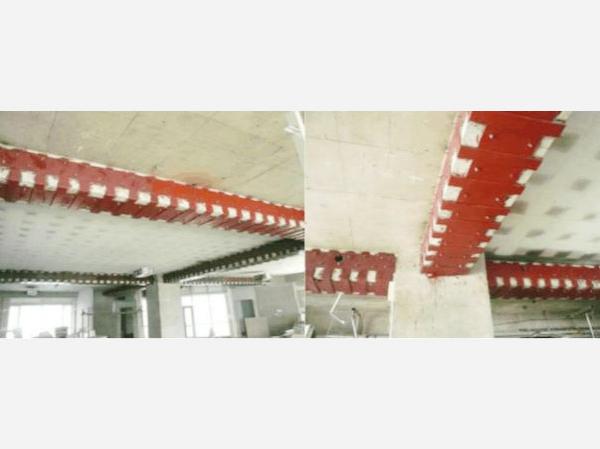4, the construction method
4.1. Pasting surface processing
4.4.1. cutting out the plaster layer,oil and dirt of the concrete pasting surface, and then using Angle grinding machine to remove the 2-3mm thick surface of the concrete surface, after polishing, using the compressed air to blow off the dust, and finally using the cotton cloth with acetone to wipe the surface, repairing the larger cavity with concrete repair adhesive.
4.1.2. The pasting surface of the steel plate should be done the rough handling with the angle grinder until it has the metallic luster, and then using cotton cloth with acetone to wipe clean the surface, reserving it after it is completely dry.
4.1.3. The main equipment of the process: the impact hammer and flat spade, hammer, angle grinder, diamond grinding slice, grinding wheel slice, strong blower, degreasing cotton cloth, acetone, goggles, rustproof masks.
4.2 pressure fixing and unloading system preparation
4.2.1.the live load like the personnel and office machines that the components bear should be temporarily removed, and trying to reduce the temporary load of the construction.
4.2.2. using the bolt for the pressure fixing, drilling hole on the steel plate, anchoring the screw, it will produce the composite anchorage force for the steel plate. the effect is good, and it is suitable for pasting steel plate.This project adopts the
4.2.3 this project uses the bolt hole. the space distance is 200 ㎜. the bolt specification is M8 * 70.
4.3. making up the bonded steel structural adhesive.
4.3.1.the bonded steel structural adhesive is divided into A and B two parts. the specific mixture ratio should be in accordance with the requirements of the product specifications.Taking out the clean containers (plastic or metal basin, do not have oil, water or impurities) mixing it with the weighing scales according to the mixture ratio, and using blender to mix them about 5 minutes until A and B parts are even. when mixing, it is recommended to mix it along the same direction, and avoiding mixing with air to form the bubble.
4.3.2. it is not appropriate to make up too much adhesive every time. once finishing making up, using it.
4.3.3. The main equipment used for the process: blender, container, weighing apparatus, putty knife and gloves.
4.4. painting the adhesive and pasting
4.4.1. after making up the bonded steel adhesive, using the putty knife to smear it on the surface of steel plate(or the concrete surface) that has been managed, the cross section of adhesive should be triangle. the thickness of the middle part is about 3 mm, and the edge is about 1mm. and then pasting the steel plate on the concrete surface, fixing it with the prepared fixing pressure system (bolt), pressuring it appropriately. it is the most appropriate that the adhesive just squeezes out the steel plate seam.
4.4.2. the order of pasting the steel: pasting the steel at the bottom of the plate(pasting short span transverse tensile steel plate firstly, and then pasting the layerings on the both ends); Sticking the steel at the bottom of the beam (pasting the steel plate of the beam bottom, and then pasting the “U-shaped” hoop plate, finally pasting the layering. If the height of this project’s beam is equal to or higher than 600 mm, setting up two thick steel plate layering of 100mm wide and 3mm thick at the top of beam plate bottom) and the middle of the beam height,the length is commonly set, using M8 bolts to fix and pressure).
4.4.3. The main instruments used for this process: bolt, hammers, putty knife and gloves.
4.5.Solidified,maintained bonded steel structural adhesive can solidify well both at normal or low temperature. if the curing temperature is about 25℃, we can remove the pressure fixing system after 24 hours. it can be used normally after 72 hours. if the curing temperature is about 5℃, we can remove the pressure fixing system after 48 hours. it can be used normally after 120 hours.
4.6.Checking that the operating performance of the bonded steel structural adhesive is excellent. normal operation can reach 100% plumpness. using small hammer to tap the bonded steel gently when checking. judging the effect of pasting from the stereo. ultrasonic instrument can also be adopted to test. if the effective pasting area of anchorage zone is less than 90% and the effective passing area of none-anchoring zone is less than 70%, removing the steel plate and pasting it again
4.7. after maintenance and reinforcement, steel plate can adopt 25mm and 1:3 cement mortar plaster to be protected in order to prevent the rust. it can also be coated antirust paint to be protected.
4.8. notes: whether the pasting surface is managed according to the requirements. whether the adhesive ratio is accurate. whether it is mixed evenly. whether the adhesive layer is even and dense determines the effect of pasting.



